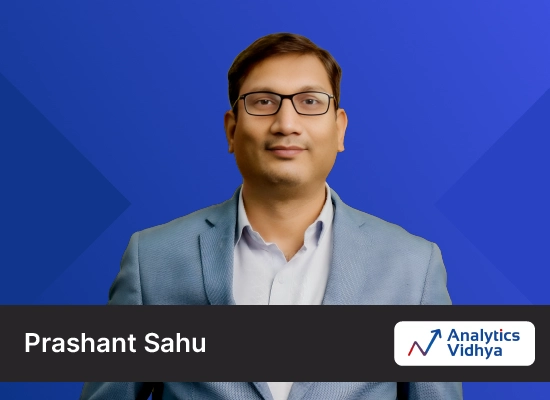A Comprehensive Learning Path to Become a Data Scientist in 2025
BeginnerLevel
3000+Students Enrolled
2 Hrs Duration
4.8Average Rating

About this Course
- Follow a structured learning path designed to help you begin your data science career with clarity, making the complex field more manageable and focused on essential skills.
- Master the most in-demand skills for 2023, including effective storytelling, model deployment, and other crucial competencies to stand out in the competitive data science field.
- Gain hands-on experience with carefully designed exercises and assignments that allow you to apply your knowledge and build real-world skills in data science.
Learning Outcomes
Detail Data Science Path
A structured journey to kickstart your data science career.
Essential 2025 Skills
Learn in-demand skills and deployment and master the important skills.
Practical Exercises
Build hands-on experience with exercises and assignments.
Who Should Enroll
- Aspiring Data Scientists: Ideal for those starting a career in data science and looking for a structured learning path.
- Professionals : Perfect for professionals wanting to transition into data science with a focused learning journey
- Tech Enthusiasts : Great for anyone passionate about data science and wanting to develop in-demand skills for 2025.
Course Curriculum
Explore a comprehensive curriculum covering Python, machine learning models, deep learning techniques, and AI applications.
1. Overview of Learning Path in data science
2. Month-on-Month Action Plan
3. AI&ML Blackbelt Plus Program
1. Plan for January
2. Understanding Machine Learning and its impact
3. Job of Data Scientist
4. Overview of the Course
5. A brief introduction to Python
6. Installing Python
7. Theory of Operators
8. Understanding Operators in Python
9. Operators Test
10. Understanding variables and data types
11. Variable Test
12. Variables and Data Types in Python
13. Understanding Conditional Statements
14. Implementing Conditional Statements in Python
15. Conditional Statements test
16. Understanding Looping Constructs
17. Implementing Looping Constructs in Python
18. Looping Constructs test
19. Understanding Functions
20. Implementing Functions in Python
21. Functions test
22. A brief introduction to data structure
23. Data Structure test
24. Understanding the concept of Lists
25. Lists test
26. Implementing Lists in Python
27. Understanding the concept of Dictionaries
28. Implementing Dictionaries in Python
29. Dictionaries test
30. Understanding the concept of Standard Libraries
31. Libraries test
32. Reading a CSV File in Python - Introduction to Pandas
33. Reading a CSV file in Python: Implementation
34. Reading a csv file in Python test
35. Understanding dataframes and basic operations
36. DataFrames and basic operations test
37. Reading dataframes and conduct basic operations in Python
38. Reading dataframes and conduct basic operations in Python Test
39. Indexing a Dataframe
40. Indexing DataFrames test
41. Sorting Dataframes
42. Merging Dataframes
43. Apply function
44. Aggregating data
45. Basics of Matplotlib
46. Data Visualization using Matplotlib
47. Basics of Seaborn
48. Data Visualization using Seaborn
49. Regular Expressions
50. Understanding Regular Expressions
51. Regular Expressions in Python
52. Cheatsheet for Python
53. Instructions
54. Python Coding Challenge
1. The Power of Visualization
2. What is Data Visualization and Why Should we Use it
3. Exercise - Definition of Data Visualization
4. Hans Rosling - 200 Countries 200 Years 4 Minutes
5. 4 Key Elements of Effective Data Visualizations
6. Why Tableau is a Powerful Tool for Professionals
7. What We Will Cover in this Course
8. Compare Tableau Against Power BI and Qlik
9. The Tableau Range of Products
10. The 5 Tableau Products you should Know
11. Installing Tableau Public on your System
12. Navigating the Tableau Interface
13. Installing Tableau Public on your System
14. Difference Between Tableau Server and Tableau Online
15. Navigating the Tableau Interface (Part 1)
16. Navigating the Tableau Interface (Part 2)
17. Connecting to Data Sources in Tableau
18. Understanding the Problem Statement
19. Download the Superstore Dataset
20. Loading the Dataset and Getting Familiar with the Variables
21. Build your First Visualization in Tableau!
22. Hands-On with Labels and Formatting
23. Playing Around with Colors
24. Using Filters to Build a Pivot Structure in Tableau
25. Exporting your Tableau Worksheet
26. The Different Chart Types in Tableau
27. Line Charts - Working with Time Series Data
28. Building Line Charts in Tableau
29. Exercise - Sales of Each Category Month-by-Month
30. Generating Map Visualizations for Geospatial Analysis
31. Map Visualizations in Tableau
32. Exercise - Sales by City Analysis
33. Bar Charts, Histograms, Scatter Plots, Bubble Charts, Pie Charts
34. Dual Axis Charts in Tableau
35. Date Dual Axis Charts in Tableau
36. What are Calculated Fields?
37. Feature Engineering in Tableau - Average Shipping Time
38. Exercise - Number of Orders per State
39. Calculating the Average Order Value
40. Average Order Value for Product Sub-Categories
41. What are Parameters in Tableau?
42. Using Parameters to find Top N Customers
43. Using Parameters to Analyze Superstore's Variable Values
44. Joins and their Different Types in Tableau
45. Performing Data Joining in Tableau
46. What is Blending? How is it Different from Joins?
47. Blending Data in Tableau
48. Download the Coffee Chain Dataset
49. Introduction to Dashboards and their Use Cases
50. Reading Material - Dashboards in Tableau
51. Designing your First Dashboard in Tableau
52. Using Parameters to Create Dynamic Dashboards
53. How to Upload your Work to the Tableau Public Gallery
54. Designing the Blueprint for a Multi-Dashboard View to Analyze Sales
55. Building Multiple Interlinked Dashboards in Tableau for our Business
56. The Art of Storytelling
57. 3-Step Storytelling Framework
58. Sketching the Story Blueprint
59. Profits by Region Analysis using Storyboard in Tableau
60. Capstone Project: Sales and Profit by Segment using Storyboards in Tableau
61. Getting started with SQL
62. Introduction
63. Why do we need databases?
64. What is a database?
65. Some properties of a Good Database
66. Types of Databases
67. How data is Stored in Relational Databases
68. How data is stored in NoSQL databases
69. Companies using MySQ
70. Architecture: Client and Server
71. MySQL Distributions
72. Local Installation on Mac
73. Local Installation on Linux
74. Local Installation on Windows
75. Accessing a remote MySQL server
76. Graphical user interfaces
77. SQL - Installation Guide
78. What exactly is SQL?
79. History of SQL
80. Connecting to MySQL
81. Types of Commands - DDL (Creation/ Deletion/ Updating of Schema
82. Types of Commands - DML (Manipulating data in tables)
83. Types of Commands - DCL (Managing Access control)
84. Exploring databases
85. Creating tables
86. Inserting data in tables
87. SELECT Statement - Introduction
88. Datatypes in MySQL
89. NULL vs NOT NULL
90. Update command – Concept
91. Update command – Example
92. Delete command – Concept
93. Delete command – Example
94. Describe command – Concept
95. Describe command – Example
96. Alter command – Concept and Example
97. Importing data from CSV to MySQL
98. Exporting data from MySQL to CSV
99. Backing up databases
100. Restoring databases
101. Importing and Exporting Datasets - Troubleshooting Guide
102. Counting Rows and Items
103. Aggregation Functions – SUM, AVG, STDDEV
104. Extreme Values Identification – MIN, MAX
105. Filtering Patterns
106. Groupings, Rolling up data and Filtering in Groups
107. Data Eyeballing
108. Data Dictionary
109. Questions we need answers of
110. Analyzing data and creating table structure
111. Loading data to our MySQL table
112. Data Analysis – Simple Queries
113. Data Analysis – Advanced Queries
114. FIFA19 Players dataset (cleaned) for this Project
115. The need for joins
116. Different type of joins
117. The Left Join - Concept
118. The Left Join – Practical Example
119. The Inner Join
120. The Cross Join
121. The Right Join
122. The Self Join
123. Introduction to Indexing
124. How indexing works (basics)
125. Knowing Relationships
126. Types of Relationships
127. Table Constraints – PRIMARY KEY, FOREIGN KEY, UNIQUENESS and AUTO INCREMENT
128. String functions - CONCAT
129. String functions – Case Conversion
130. String functions – Trimming Strings
131. String functions – Extracting Substrings
132. Date/ Time functions – Current date and time
133. Date/ Time functions – Extracting date and time from field
134. Date/ Time functions – Formatting date and time as Strings
135. Numeric functions
136. SQL CheatSheet
137. Setting up a virtual environment
138. Installing the required packages
139. Connecting to MySQL
140. Connecting to database table and pulling data
141. Querying the database- INSERT
142. Querying the database- DELETE
143. Querying the database- SEARCH
144. Querying the database- INDEXING
1. Overview of Statistics
2. Important applications of Statistics
3. What is Descriptive Statistics?
4. Introduction to Design experiments
5. Visualizing Data
6. Central tendency
7. Unimodal Distribution of Data
8. Bimodal Distribution of Data
9. Normal distribution – Part 1
10. Normal distribution – Part 2
11. Understanding Z-Score
12. Introduction to Probability- An Overview
13. Principal Of Counting
14. Conditional Probability – Part 1
15. Architecture: Client and Server
16. Binomial Distribution
17. Random variable
18. Expectation and variance
19. Statistics: Inferential-Hypothesis Testing
1. Overview of Machine Learning
2. Understanding Data Science Pipeline
3. Linear Regression
Meet the instructor
Our instructor and mentors carry years of experience in data industry
Get this Course Now
With this course you’ll get
- 2 Hours
Duration
- Kunal Jain
Instructor
- Beginner
Level
Certificate of completion
Earn a professional certificate upon course completion
- Globally recognized certificate
- Verifiable online credential
- Enhances professional credibility

Frequently Asked Questions
Looking for answers to other questions?
The course focuses on the most in-demand skills for 2025, such as advanced machine learning, data ethics, automation, and how to present insights effectively through storytelling.
The course includes data analysis, machine learning algorithms, model deployment, data visualization, and storytelling techniques—all essential for a career in data science.
You will learn to use popular tools and technologies such as Python, R, TensorFlow, scikit-learn, SQL, and cloud platforms for data processing, model building, and deployment.
Popular free courses
Discover our most popular courses to boost your skills
Contact Us Today
Take the first step towards a future of innovation & excellence with Analytics Vidhya
Unlock Your AI & ML Potential
Get Expert Guidance
Need Support? We’ve Got Your Back Anytime!
+91-8068342847 | +91-8046107668
10AM - 7PM (IST) Mon-Sun[email protected]
You'll hear back in 24 hours








































